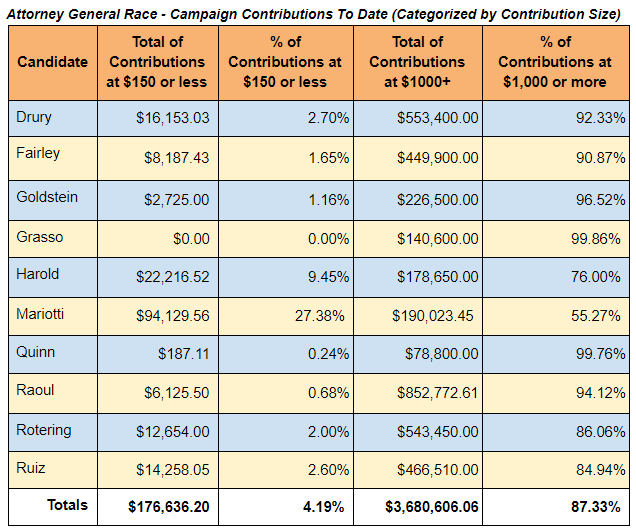Big Money Dominates in Race for Attorney General
As Illinois voters prepare to elect candidates for many top government offices in 2018, it is increasingly apparent that candidates must compete in a “money primary” in addition to regular primary elections.
As Illinois voters prepare to elect candidates for many top government offices in 2018, it is increasingly apparent that candidates must compete in a “money primary” in addition to regular primary elections.
While the scale of campaign financing is an important part of any election analysis, it is only part of the story. Just as significant, is the type of donors contributing to these staggering numbers. Not only is more money going into elections, but campaign finance is increasingly dominated by “big money” from a small selection of wealthy donors.
The role of big money in the race for Governor, which features wealthy self-funding candidates from both parties, is clear. By analyzing the race for Attorney General as well, one sees that big money dominance is not simply a quirk unique to the circumstances of this year’s race for Governor, but an increasingly ingrained feature of campaign financing in Illinois elections.
Contributions
Campaign contribution disclosures for the last quarter of 2017 were submitted Tuesday, January 16.
In 2017, 87 percent of funds raised by candidates for Attorney General came from donors who gave $1000 or more, with only 4 percent received from donors who gave $150 or less.
Even without candidates as wealthy as Governor Rauner or J.B. Pritzker, the dominance of large campaign contributions in the race for Attorney General is parallel to fundraising patterns visible in the gubernatorial race.

In all of 2017, candidates for Attorney General received 96% of their funds from just over 1700 individual contributors. In fact, the top two contributors alone gave three times the combined total contributions of all the individuals who gave $150 or less.
Renato Mariotti is an outlier, having raised 27 percent of his campaign funds from donors giving $150 or less. This likely is because of his national profile as a television and twitter personality critiquing President Trump.
Removing Mariotti’s figures, the total percentage across all campaigns of individuals giving $150 or less falls by nearly half—from 4 percent to only 2 percent.
Small Donor Matching Program
Candidates who lack access—or whose platform does not appeal—to this small pool of big-money donors face challenges in running a competitive campaign, even if they otherwise would have support from a large portion of the electorate.
As seen by the data, the supermajority of candidates’ campaign funds raised in 2017 came from donors who gave $1000 or more. Due to a greater emphasis on larger contributions, candidates are sorted and filtered not only by votes in the actual primary elections, but also by candidates’ ability to raise big money from a small, elite pool of donors. This can result in candidates dropping out of a race, and removing themselves as an option for voters, before any voting even happens.
There are successful, proven models to combat this “money primary” by empowering small donors so that their voices play a more central role in our democracy. For example, in New York City’s 2013 City Council campaigns, small donors were responsible for 61 percent of participating candidates’ contributions, when funds from a matching program were included. All but two of the winning candidates participated in the program, showing that candidates can raise the money they needed to win without looking for large-dollar contributions.
Seeking to replicate these successes across the country, good government groups have called for small donor empowerment reforms. With such reforms, candidates would be able to run competitive campaigns with a strong grassroots base of support, even if they do not have big money support.
In 2015, when an advisory question appeared on the Chicago municipal ballot, 79 percent of voters supported enacting a small donor matching program. On May 16th, 2017, the Illinois Senate passed a Small Donor Matching Bill (SB 1424) with bipartisan support. This bill creates a small donor matching system for Illinois’ state-level elections. The legislation has now progressed to the Illinois House of Representatives.
Although it is true that money alone does not win elections, and that the candidate with the most money does not always win, the Illinois campaign finance system requires that candidates seek the vast majority of their financial backing from a small pool of elite donors. This makes a strong case for the need to change how campaigns are funded, for a better, more robust, participatory democracy.
Closer to the March primaries, we will release another report that models a small donor matching system in Illinois elections.